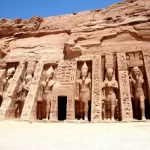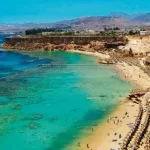Sharm El Luli Egypt

Sharm El Luli Egypt
Far away from the crowded resorts and bustling tourist trails of Egypt’s Red Sea coast lies a hidden gem that travelers call a slice of heaven on Earth—Sharm El Luli. Nestled south of Marsa Alam, this beach is where the desert kisses the sea, where simplicity meets serenity, and where nature reigns untouched.
No hotels. No Wi-Fi. No souvenir shops. Just soft white sand, turquoise waters, and a world of coral reefs teeming with marine life. It’s not just a beach—it’s a place to reset your soul.
Sharm El Luli (sometimes spelled Sharm el-Luli or Sharm El Loly) is the kind of place you stumble upon in a travel magazine and think, “Can this be real?” Spoiler alert: it is—and it’s even better in person.
Where Is Sharm El Luli Located?
Sharm El Luli is located on Egypt’s southeastern Red Sea coast, approximately 50 kilometers south of Marsa Alam. It’s part of the Wadi El-Gemal National Park, a protected area that includes mangroves, desert mountains, coral reefs, and rare wildlife.
Getting there:
-
From Marsa Alam International Airport: 90-minute drive
-
From Hurghada: Approximately 5–6 hours by car
-
Private tour buses or taxis are the most common transport methods
Its remote location is what makes Sharm El Luli so magical. The fewer roads, the fewer crowds—and the more unspoiled and tranquil the beach remains.
What Makes Sharm El Luli Special?
Sharm El Luli is completely undeveloped, which is a rarity in Egypt’s fast-growing tourism scene. This isn’t a place for beachfront bars or waterparks. This is barefoot luxury, where your entertainment is:
-
Watching the sunlight dance on shallow waters
-
Snorkeling above living coral gardens
-
Spotting sea turtles and dugongs
-
Sitting in meditative silence, hearing only the waves and your breath
It’s a natural lagoon, which means calm waters year-round—ideal for beginner snorkelers and those who just want to float in peace.
History of Sharm El Luli
The name “Sharm” means bay in Arabic, and “El Luli” could refer to local pearls or softness—fitting for its silky white sands.
While not historically significant in the pharaonic or Roman sense, the beach has long been revered by local Bedouins, who used the surrounding mangroves and desert trails for centuries. Today, their presence remains part of the charm—offering tea, stories, and cultural insight to respectful visitors.
The Perfect Day at Sharm El Luli
Morning: Arrive early. The sun rising over the Red Sea paints the water in shades of pink and orange. Take a stroll, dip your toes, and claim your favorite spot under the open sky.
Midday: Don your snorkel and explore the underwater Eden. Colorful fish, anemones, and occasional turtles glide by in the clear waters. There’s minimal current, so it’s safe and serene.
Afternoon: Sip Bedouin tea or nibble on a packed lunch. There are no restaurants, so bring your own supplies. Nap in the shade, read, or simply do nothing.
Sunset: Watch the light fade across the horizon in silence so pure it hums. The sand cools, the wind whispers, and the soul smiles.
The Marine Life of Sharm El Luli
What sets this beach apart is its bio-diverse reef system. The shallow coral shelves are easily accessible from shore—no boats needed.
Expect to see:
-
Parrotfish
-
Clownfish (Nemos!)
-
Blue-spotted stingrays
-
Moray eels
-
Occasionally, green turtles and even dugongs (sea cows), especially near Abu Dabbab Bay, just north of Sharm El Luli
It’s like swimming in a giant, open-air aquarium.
Snorkeling and Diving in Sharm El Luli
You don’t need to be a pro to enjoy the reef. The best snorkeling spots lie just 10–20 meters offshore.
Tips:
-
Bring reef-safe sunscreen
-
Wear water shoes—some areas have sharp coral
-
Bring your own snorkel gear or rent from Marsa Alam
While Sharm El Luli is ideal for snorkeling, certified divers can explore deeper reefs nearby. Wadi El-Gemal dive sites offer spectacular drop-offs and less-crowded marine experiences than Hurghada or Sharm el-Sheikh.
Eco-Tourism and Responsible Travel
As part of Wadi El-Gemal National Park, Sharm El Luli is a protected zone. Visitors are expected to:
-
Take all trash back with them
-
Avoid stepping on or touching coral
-
Refrain from feeding or chasing marine life
-
Respect local customs and wildlife
Abu Dabbab and Nearby Attractions
Just a short drive from Sharm El Luli is Abu Dabbab Bay, famous for its dugongs—the gentle “sea cows” that graze on seagrass meadows. These rare, endangered creatures can sometimes be seen swimming alongside turtles and snorkelers.
Other nearby attractions include:
-
Qulaan Mangroves: A surreal ecosystem where mangrove trees grow right out of saltwater, attracting birds, fish, and photographers.
-
Wadi El-Gemal National Park: A vast reserve where desert dunes, ancient Roman ruins, and coastal reefs co-exist. You can hike, birdwatch, or visit prehistoric rock art.
-
Hamata Islands: Often dubbed the “Egyptian Maldives”, these untouched islands offer dazzling white beaches and snorkeling that rivals any tropical destination.
These spots make Sharm El Luli an excellent base for adventure, even if it feels like the end of the world.
The Desert Meets the Sea
Sharm El Luli’s most breathtaking feature isn’t just the sea—it’s the contrast between land and water. Behind the tranquil lagoon lies a backdrop of golden desert. Camel caravans occasionally wander by, leaving footprints in the sand. Desert foxes, falcons, and wild goats roam the cliffs.
It’s the perfect meeting point of two ecosystems, both raw and regal.
Some tours even offer a desert safari + snorkel combo, giving you the best of both worlds in a single, unforgettable day.
Getting to Sharm El Luli
Getting to Sharm El Luli requires a bit of planning, but that’s what keeps it special.
From Marsa Alam:
-
Private car or taxi (90 minutes)
-
Tour group shuttle (book through hotels or local agencies)
From Hurghada:
-
Private transfer (5–6 hours)
-
Combine with overnight stay in Marsa Alam
There are no buses or public transport, which makes it less accessible—and more pristine.
Best Time to Visit Sharm El Luli
Sharm El Luli is accessible year-round, but the best time to visit is between October and April when temperatures are pleasant and underwater visibility is excellent.
Monthly Weather Snapshot:
| Month | Temp (°C) | Snorkeling Conditions |
|---|---|---|
| Jan–Feb | 20–24 | Calm, cool, fewer crowds |
| Mar–Apr | 24–28 | Ideal temperatures, great visibility |
| May–Sep | 30–40+ | Hot, but water is warm |
| Oct–Dec | 24–28 | Best sunsets and reef visibility |
Avoid visiting during peak summer afternoons unless you thrive in extreme heat.
What to Pack for Your Trip
Packing Essentials for Sharm El Luli:
-
Reef-safe sunscreen (no aerosols)
-
Snorkel gear and water shoes
-
Hat, sunglasses, and light cover-up
-
Snacks, water, and eco-friendly utensils
-
Beach mat or towel
-
Waterproof phone pouch or GoPro
-
Binoculars (for birds and desert wildlife)
-
Small trash bag to pack out waste
Remember: there are no facilities—no bathrooms, no restaurants, no shops. Come prepared, leave nothing behind.
Beach Activities Beyond Swimming
While snorkeling is the star attraction, there’s more to do:
-
Kayaking (available via some tour operators)
-
Birdwatching (herons, kingfishers, ospreys)
-
Nature walks along the shore and dunes
-
Shell collecting—just observe, don’t take
-
Star gazing at night in one of the clearest skies in Egypt
If you’re lucky, you might spot bioluminescence in the water after dark—a glowing dance of plankton responding to your movement.
Local Culture and Hospitality
Sharm El Luli sits near Bedouin settlements, and many tours are run by local tribespeople who have deep knowledge of the land and sea.
Enjoy:
-
Freshly brewed Bedouin tea
-
Handmade crafts and scarves
-
Desert stories and hospitality that money can’t buy
Be respectful, ask before taking photos, and support local guides whenever possible.
Safety Tips for Visiting Sharm El Luli
-
Watch for sharp coral—don’t step on it
-
Stay hydrated—heatstroke is no joke
-
Bring a dry bag for electronics
-
Be cautious of strong sun between 11 AM – 3 PM
-
Check with local guides about jellyfish sightings (rare)
-
Don’t snorkel too far from shore unless you’re experienced
Safety comes naturally when you respect nature’s pace and space.
Environmental Challenges
Though Sharm El Luli remains pristine, it’s not immune to threats:
-
Coral bleaching from warming seas
-
Rising interest from tourism developers
-
Trash left by careless visitors
Let’s keep it wild and wonderful by:
-
Packing out all waste
-
Educating others on reef etiquette
-
Supporting eco-certified tour companies
Every visitor is a temporary steward of this paradise.
FAQs
Is Sharm El Luli safe?
Yes, it’s one of the safest, most peaceful places in Egypt—especially for nature lovers.
Can I dive there without a license?
Not scuba dive, but snorkeling requires no certification. For dives, visit nearby Abu Dabbab.
Is there mobile coverage?
Very limited. Don’t count on it—consider it a digital detox.
How do I get there?
The easiest route is via Marsa Alam by private car or arranged tour.
What are nearby must-visits?
Abu Dabbab, Wadi El-Gemal, Qulaan Mangroves, Hamata Islands.
Do I need a permit to enter?
No, but entrance fees may apply through local tours or national park authorities.
Conclusion: Sharm El Luli – Where Silence, Sea, and Soul Collide
In a world spinning faster each day, Sharm El Luli offers stillness. It’s a place where time slows, where beauty speaks in blues and beiges, and where the line between earth and heaven is drawn in white sand.
You won’t find five-star hotels or neon signs here. You’ll find something better: peace, presence, and purity.
So if you’re looking for the loudest silence, the clearest water, and a sky that hugs you like home—Sharm El Luli is calling.







Good https://is.gd/N1ikS2
Good https://is.gd/N1ikS2
Awesome https://is.gd/N1ikS2
Good https://is.gd/N1ikS2
Awesome https://is.gd/N1ikS2
Awesome https://is.gd/N1ikS2
Very good https://shorturl.fm/bODKa
Very good https://shorturl.fm/bODKa
https://shorturl.fm/YvSxU
https://shorturl.fm/m8ueY
https://shorturl.fm/A5ni8
https://shorturl.fm/68Y8V
https://shorturl.fm/oYjg5
https://shorturl.fm/FIJkD
https://shorturl.fm/oYjg5
https://shorturl.fm/N6nl1